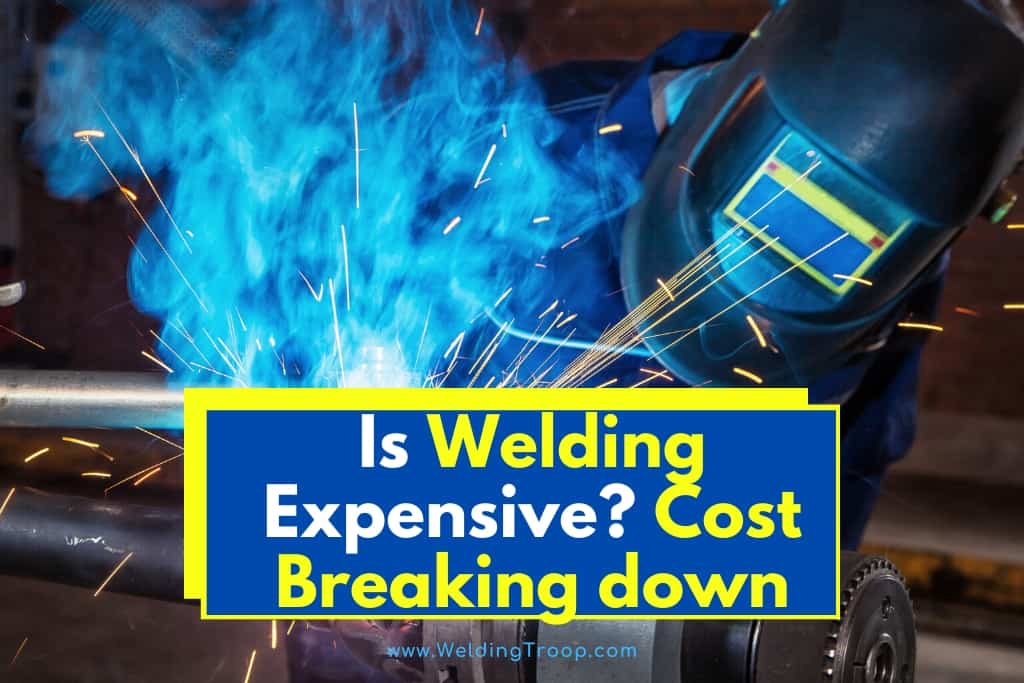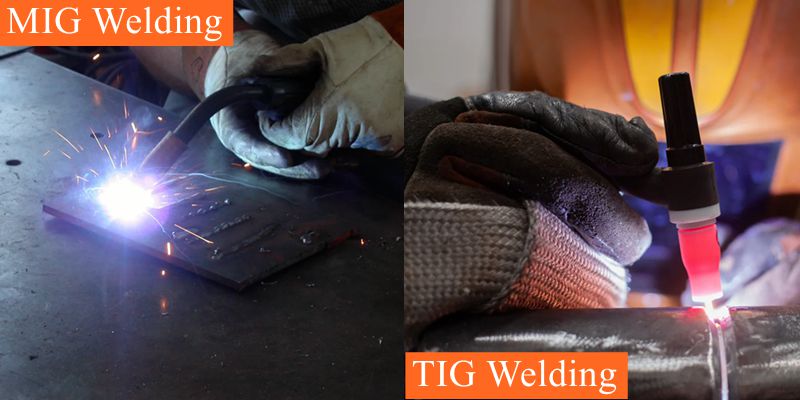MIG welding costs can vary widely depending on the scale and complexity of the project. For small DIY projects, it can be relatively inexpensive, with basic equipment costing between $400 and $2,000. For larger commercial or industrial projects, costs can escalate due to the need for more advanced equipment, higher quality materials, and skilled labor. Additionally, ongoing expenses for materials like wire and gas, and maintenance of the equipment, should be considered. Ultimately, whether MIG welding is considered expensive depends on the specific context and budget constraints.

Cost Breakdown of MIG Welding
Equipment Costs
- MIG Welder
- The price of a MIG welder can range from $400 to $2000 depending on the brand, power output (typically ranging from 100 to 600 Amps), and features. For example, a Hobart Handler 210 with 210 Amps output may cost around $900.
- Safety Gear
- Welding helmets, gloves, and safety glasses are essential. A quality auto-darkening welding helmet might cost between $50 and $300.
- Maintenance and Repairs
- Regular upkeep of a MIG welder can run around $100 per year, depending on usage.
Material Costs
- Welding Wire
- Costs vary based on material type and thickness. A spool of 0.035-inch ER70S-6 wire might cost around $25.
- Shielding Gas
- A tank of 80% Argon and 20% CO2 blend might cost around $50 to refill.
- Base Metals
- The cost of the base metal being welded can vary greatly, e.g., a 4′ x 8′ sheet of 1/4″ steel may cost around $100.
Labor Costs
- Welder’s Wage
- The average wage for a MIG welder in the United States might be around $20 per hour, but this can vary significantly by region and level of experience.
- Training and Certification
- Costs for a basic welding certification program might range from $5,000 to $15,000.
Operational Costs
- Electricity Consumption
- Operating a 200 Amp MIG welder at a duty cycle of 20% might consume around 6 kWh per hour of use, at an average cost of $0.12 per kWh, thus costing around $0.72 per hour.
- Shop Space
- Renting a commercial space for welding might cost between $1,000 and $5,000 per month, depending on the location and size.
- Insulation and Ventilation
- Proper insulation can reduce energy costs, and adequate ventilation is necessary for safety. Installing a professional-grade ventilation system might cost around $3,000.

Factors Affecting the Cost of MIG Welding
Skill Level of the Welder
- Apprentice vs Experienced Welder
- An apprentice welder might earn around $15 per hour, while an experienced welder might command upwards of $25 per hour. The higher wage of skilled welders contributes directly to the overall cost of a MIG welding project.
- Certifications and Specializations
- Welders with specific certifications might have a higher hourly rate. For example, a certified pipe welder might earn $30 per hour, raising the project’s labor costs.
Type and Thickness of Material
- Material Type
- Welding stainless steel generally costs more than welding mild steel due to the higher price of stainless steel. For instance, 1 lb of stainless steel filler wire might cost $11, whereas the same weight of mild steel wire might cost around $6.
- Material Thickness
- Thicker materials require more filler wire and time. Welding a 1/2″ thick plate, for example, might consume thrice the amount of filler wire and nearly double the time compared to welding a 1/4″ thick plate.
Geographic Location
- Urban vs Rural Areas
- In urban areas, the cost of living and operational costs are usually higher. For instance, the average hourly wage for a welder in New York City might be $27, while in a rural area in the Midwest, it might be $20.
- Local Market Competition
- In areas with more welders and competition, prices might be lower. For example, in a small town with few welding shops, a welder might charge $50 per hour due to lack of competition.
Scale and Complexity of the Project
- Project Duration
- A two-week project might have labor costs of $4,000 (based on an hourly rate of $25 and a 40-hour workweek), whereas a two-month project might have labor costs upwards of $16,000 under the same conditions.
- Complexity and Special Requirements
- Projects requiring detailed or intricate welds, or special certifications (e.g., ASME) may increase the price. For example, a project requiring underwater welding might cost 50% more than a similar project in a more accessible location due to the unique skills and risks involved.
- Equipment Needed for Large-Scale Projects
- For larger projects, more advanced and powerful welders might be required. For example, a 350 Amp welder might be needed for a large industrial project, costing around $4,000, while a smaller project might only need a 200 Amp welder costing around $1,500.
Cost Comparison with Other Welding Methods
MIG Welding vs TIG Welding
- Equipment Costs
- A MIG welder typically costs between $400 and $2000, whereas a TIG welder often starts at $800 and can go up to $5000, reflecting the precision and complexity of TIG welding.
- Labor Costs
- TIG welding generally requires a more skilled operator, hence higher labor costs. A TIG welder may earn around $26 per hour, compared to $20 per hour for a MIG welder.
- Speed and Efficiency
- MIG welding is usually faster than TIG welding. For example, MIG welding can often complete a project in 5 hours that might take 8 hours with TIG welding, thereby reducing labor costs.
- Material Costs
- TIG welding often requires costlier filler materials, with rods costing around $20 per pound compared to MIG wire which might cost around $6 per pound.
MIG Welding vs Stick Welding
- Equipment Costs
- Stick welders are generally cheaper, ranging from $200 to $800, compared to the $400 to $2000 range for MIG welders.
- Operational Costs
- Stick welding electrodes cost around $10 per pound, whereas MIG wire might cost around $6 per pound. Additionally, Stick welding often produces more waste material.
- Skill Requirement and Labor Costs
- Stick welding is generally more forgiving of imperfect surfaces but often requires a skilled operator. The wage rates for stick welders are similar to MIG welders, generally around $20 per hour.
- Efficiency and Time
- MIG welding tends to be faster than stick welding. A project that takes 5 hours with MIG might take 7 hours with stick welding due to the need to replace electrodes and clean slag.
MIG Welding vs Flux-cored Arc Welding
- Equipment Costs
- The cost for a Flux-cored Arc Welder is generally similar to MIG welders, ranging from $500 to $2500.
- Material Costs
- Flux-cored wire typically costs more than solid MIG wire, e.g., $8 per pound compared to $6 per pound for solid MIG wire.
- Operational Efficiency
- Flux-cored welding often allows for higher welding speed and greater metal penetration, making it more time-efficient in some cases.
- Versatility and Conditions
- Flux-cored welding does not require a shielding gas, which can reduce costs and make it a more viable option for windy or outdoor conditions.
Case Studies: MIG Welding Cost Scenarios
Small DIY Projects
- Project Example: Building a Garden Gate
- Materials: 20 feet of steel tubing ($40), 2 lbs of MIG wire ($12), shielding gas ($25)
- Equipment: 140 Amp MIG Welder ($700)
- Labor: 6 hours @ DIY (free), or potentially $150 if hiring a welder at $25/hr
- Total Cost Estimate: $777 (DIY) or $927 (hiring a professional)
- Process and Time Efficiency
- With a 140 Amp MIG welder, a relatively quick and clean weld can be achieved, making it ideal for small projects where time is a factor.
- Value Proposition
- Achieving a strong and visually pleasing result with a reasonable budget and potential for personal satisfaction when DIY.
Mid-scale Commercial Projects
- Project Example: Restaurant Metal Interior Decorations
- Materials:
- 200 feet of steel tubing ($400)
- 10 lbs of MIG wire ($60)
- Shielding gas ($150)
- Equipment: 220 Amp MIG Welder ($1,200)
- Labor: 80 hours @ $25/hr ($2,000)
- Total Cost Estimate: $3,810
- Materials:
- Quality and Design
- With a 220 Amp MIG Welder, high-quality and precise welds can be achieved, which are essential for visible interior decorations.
- Economic Factors
- These projects typically have a higher budget, which allows for better materials and skilled labor. The end product adds aesthetic value to the restaurant.
| Item | Cost |
|---|---|
| Materials | $610 |
| Equipment | $1,200 |
| Labor | $2,000 |
| Total | $3,810 |
Large Industrial Projects
- Project Example: Constructing a Steel Frame for a Small Factory
- Materials:
- 3000 feet of steel I-beams ($15,000)
- 200 lbs of MIG wire ($1,200)
- Shielding gas ($1,000)
- Equipment: 350 Amp Industrial MIG Welder ($5,000)
- Labor: 1000 hours @ $30/hr ($30,000)
- Total Cost Estimate: $52,200
- Materials:
- Efficiency and Specifications
- With a 350 Amp industrial MIG Welder, efficient and high penetration welds can be achieved for thick I-beams, essential for structural integrity.
- Scale and Impact
- Such projects are generally high-value with stringent quality and safety requirements. The lead time is usually months and involves coordination with other trades.
| Item | Cost |
|---|---|
| Materials | $17,200 |
| Equipment | $5,000 |
| Labor | $30,000 |
| Total | $52,200 |
What is MIG welding's power source?
MIG welding typically requires a constant voltage (CV) power source, which maintains a consistent voltage level throughout the welding process.
How does MIG welding's cost compare to other methods?
MIG welding is generally cost-effective due to its efficiency and reduced need for post-weld cleaning or finishing.
What are the advantages of MIG welding in terms of efficiency?
MIG welding's high deposition rate and continuous wire feed contribute to its efficiency, allowing for faster welding speeds.
What are the typical costs associated with MIG welding?
The costs of MIG welding include the initial investment in equipment, shielding gas, and consumables like welding wire and contact tips.
Can MIG welding fit within a specific budget?
MIG welding can be adapted to various budgets, with options for both entry-level and advanced welding machines.
Are there size restrictions when it comes to MIG welding?
MIG welding can accommodate a range of metal thicknesses, making it suitable for both thin and thick materials.
What parameters should be considered in MIG welding?
Key parameters include voltage, wire speed, electrode extension, and shielding gas composition, all of which affect the weld quality.
What is the typical lifespan of MIG welding equipment?
MIG welders can have a long lifespan, often lasting for many years with proper maintenance.


